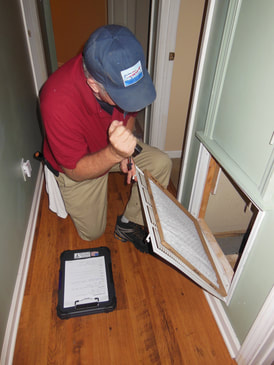|
Buying a home? It's probably the most expensive purchase you'll ever make. This is no time to shop for a cheap inspection. The cost of a home inspection is very small relative to the value of the home being inspected. The additional cost of hiring an InterNACHI-Certified Professional Inspector® is almost insignificant.
You have recently been crunching the numbers, negotiating offers, adding up closing costs, shopping for mortgages, and trying to get the best deals. Don't stop now. Don't let your real estate agent, a "patty-cake" inspector, or anyone else talk you into skimping here. InterNACHI-certified inspectors perform the best inspections by far. InterNACHI-certified inspectors earn their fees many times over. They do more, they deserve more, and -- yes -- they generally charge a little more. Do yourself a favor... and pay a little more for the quality inspection you deserve. The licensing of home inspectors only sets a minimum standard. Much like being up to code, any less would be illegal. Imaginary people, children, psychics (who claim to "sense" if a house is OK) and even pets can theoretically be home inspectors. InterNACHI, the International Association of Certified Home Inspectors, front-ends its membership requirements. InterNACHI inspectors:
Most people don’t know how easy it is to make their homes run on less energy, and here at InterNACHI, we want to change that.
Drastic reductions in heating, cooling and electricity costs can be accomplished through very simple changes, most of which homeowners can do themselves. Of course, for homeowners who want to take advantage of the most up-to-date knowledge and systems in home energy efficiency, InterNACHI energy auditors can perform in-depth testing to find the best energy solutions for your particular home. Why make your home more energy efficient? Here are a few good reasons:
As much as half of the energy used in homes goes toward heating and cooling. The following are a few ways that energy bills can be reduced through adjustments to the heating and cooling systems:
Demand-type water heaters (tankless or instantaneous) provide hot water only as it is needed. They don't produce the standby energy losses associated with traditional storage water heaters, which will save on energy costs. Tankless water heaters heat water directly without the use of a storage tank. When a hot water tap is turned on, cold water travels through a pipe into the unit. A gas burner or an electric element heats the water. As a result, demand water heaters deliver a constant supply of hot water. You don't need to wait for a storage tank to fill up with enough hot water. 3. Replace incandescent lights. The average household dedicates 11% of its energy budget to lighting. Traditional incandescent lights convert approximately only 10% of the energy they consume into light, while the rest becomes heat. The use of new lighting technologies, such as light-emitting diodes (LEDs) and compact fluorescent lamps (CFLs), can reduce the energy use required by lighting by 50% to 75%. Advances in lighting controls offer further energy savings by reducing the amount of time that lights are on but not being used. Here are some facts about CFLs and LEDs:
Sealing and insulating your home is one of the most cost-effective ways to make a home more comfortable and energy-efficient, and you can do it yourself. A tightly sealed home can improve comfort and indoor air quality while reducing utility bills. An InterNACHI energy auditor can assess leakage in the building envelope and recommend fixes that will dramatically increase comfort and energy savings. The following are some common places where leakage may occur:
The following systems can be installed to conserve water usage in homes:
Appliances and electronics account for about 20% of household energy bills in a typical U.S. home. The following are tips that will reduce the required energy of electronics and appliances:
Daylighting is the practice of using natural light to illuminate the home's interior. It can be achieved using the following approaches:
About one-third of the home's total heat loss usually occurs through windows and doors. The following are ways to reduce energy lost through windows and doors:
An enormous amount of energy is wasted while cooking. The following recommendations and statistics illustrate less wasteful ways of cooking:
|
HIGH RANGE HOME INSPECTIONHigh Range Home Inspection is a full service home inspection company. We specialize in mountain homes, Estates and unique properties. We offer consulting on remodel projects, contractor oversight, vacation home checks, and more. We are proud to be a locally owned business that services Boulder, Nederland, Longmont, Allenspark, Estes Park, Loveland, Denver, and surrounding areas in the Front Range.
|
CONTACT
|
SERVICES |
578 Primos Road Boulder, Colorado 80302-9212
TERMS OF SERVICE
©
2018 High Range Home Inspection LLC




 RSS Feed
RSS Feed
